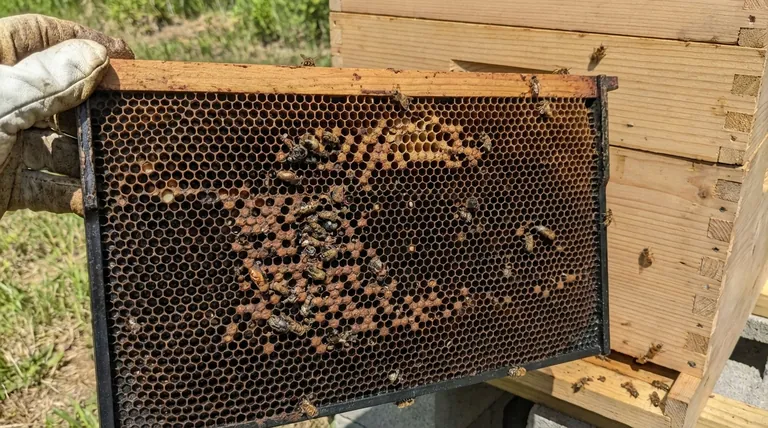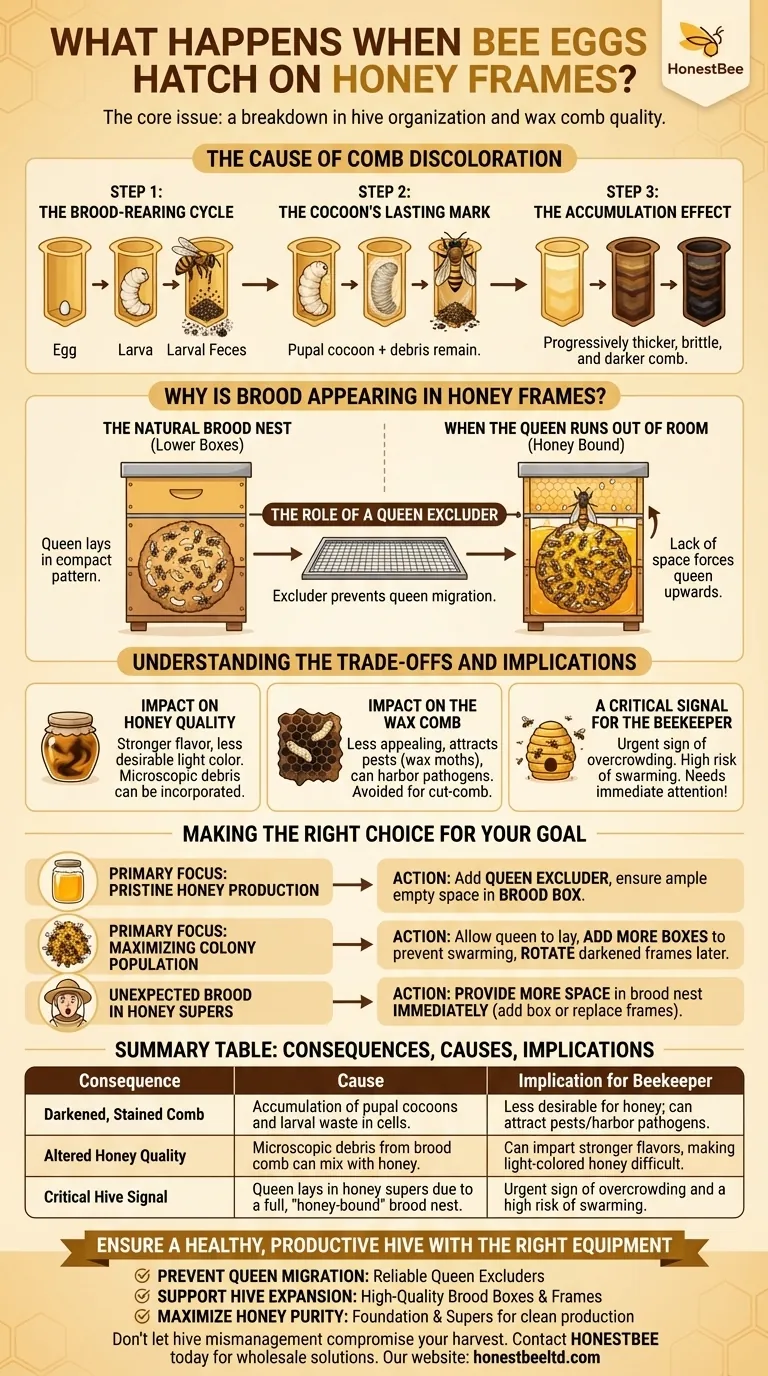To be direct, allowing bee eggs to hatch on honey frames causes the wax comb to become stained dark brown over time. This happens because each emerging bee leaves behind a pupal cocoon, which, combined with larval feces and other hive debris, gets embedded into the cell walls, permanently altering their color and texture.
The core issue isn't the discoloration itself, but what it represents: a breakdown in hive organization. When a queen lays eggs in frames meant for honey storage, it's a critical signal that she lacks adequate space in the brood nest, requiring the beekeeper's immediate attention.

The Cause of Comb Discoloration
To understand why honey frames turn dark, we must look at the natural life cycle of a honey bee and how it interacts with the wax comb. This process is perfectly normal in the brood area but becomes problematic in honey supers.
The Brood-Rearing Cycle
The queen lays an egg in a wax cell. After three days, it hatches into a larva, which is fed by worker bees. As the larva grows, it defecates within the cell.
The Cocoon's Lasting Mark
Before pupating, the larva spins a silken cocoon that adheres to the walls of the cell. After the adult bee emerges, this thin cocoon, along with the accumulated feces and other microscopic debris, remains behind.
The Accumulation Effect
This process repeats with every generation of brood raised in that cell. Each new cocoon is spun inside the last, causing the wax comb to become progressively thicker, more brittle, and darker, eventually turning from pale yellow to nearly black.
Why is Brood Appearing in Honey Frames?
The presence of eggs and larvae in your honey supers is not a random event. It is a direct result of specific conditions within the hive, primarily related to a lack of space for the queen.
The Natural Brood Nest
A queen bee instinctively seeks to lay her eggs in a compact, spherical pattern located in the lower boxes of the hive, known as the brood nest or brood chamber. This is where the colony raises its young.
When the Queen Runs Out of Room
If the brood nest becomes full—either with existing brood, pollen, or stored honey (a condition known as being "honey bound")—the queen will search for any available empty cells to continue laying. Often, the only space available is upwards, in the honey supers.
The Role of a Queen Excluder
Many beekeepers use a queen excluder, a screen with openings large enough for worker bees but too small for the queen. Placed between the brood boxes and honey supers, this tool physically prevents the queen from moving up and laying eggs in the honey-storage area.
Understanding the Trade-offs and Implications
While not a catastrophe, finding brood in your honey frames has several consequences for your honey, your equipment, and your hive management strategy.
Impact on Honey Quality
The honey itself is not spoiled by the presence of brood. However, extracting honey from dark brood comb can incorporate microscopic debris and impart a stronger flavor, which may be less desirable. It also makes producing clear, light-colored honey nearly impossible.
Impact on the Wax Comb
Brood comb is less appealing for honey processing and is often avoided for cut-comb honey production. Over time, the thickened, dark comb becomes more attractive to pests like wax moths and can harbor pathogens.
A Critical Signal for the Beekeeper
The most important implication is that your hive is communicating a need. Brood in the honey supers is a clear sign that the colony is feeling crowded and may be preparing to swarm. It is an urgent call to create more space for the queen to lay.
Making the Right Choice for Your Goal
Your response to finding brood in honey frames depends on your beekeeping philosophy and objectives.
- If your primary focus is pristine honey production: Immediately add a queen excluder and ensure the queen has ample empty comb in the brood box below it.
- If your primary focus is maximizing colony population: Allow the queen to lay, but be prepared to add more boxes to prevent swarming and plan to rotate the darkened frames out of the hive in the future.
- If you find brood in your honey supers unexpectedly: Provide more space in the brood nest immediately, either by adding a new box or replacing full frames with empty ones, to entice the queen back down.
Ultimately, proactive space management is the foundation of both a healthy colony and a clean honey harvest.
Summary Table:
| Consequence | Cause | Implication for Beekeeper |
|---|---|---|
| Darkened, Stained Comb | Accumulation of pupal cocoons and larval waste in cells. | Less desirable for honey; can attract pests/harbor pathogens. |
| Altered Honey Quality | Microscopic debris from brood comb can mix with honey. | Can impart stronger flavors, making light-colored honey difficult. |
| Critical Hive Signal | Queen lays in honey supers due to a full, "honey-bound" brood nest. | Urgent sign of overcrowding and a high risk of swarming. |
Ensure a Healthy, Productive Hive with the Right Equipment
Brood in your honey supers is a clear sign your hive management needs attention. HONESTBEE supplies commercial apiaries and beekeeping equipment distributors with the durable, wholesale-focused supplies needed to maintain optimal hive organization and prevent this issue.
- Prevent Queen Migration: Our reliable queen excluders ensure your honey supers remain brood-free.
- Support Hive Expansion: Provide ample space with our high-quality brood boxes and frames to keep your queen laying where she should.
- Maximize Honey Purity: Use our foundation and supers designed for clean, efficient honey production.
Don't let hive mismanagement compromise your harvest. Contact HONESTBEE today to discuss your apiary's needs and explore our wholesale solutions for commercial-scale success.
Visual Guide

Related Products
- Plastic Bee Frame Beekeeping Hive Frames for Wholesale
- Professional 500g Sectional Comb Honey Frame System for Beekeeping
- Heart-Shaped Comb Honey Frame and Honeycomb Cassette
- Assembled Wooden Bee Frames with Beeswax Foundation Ready to Use by HONESTBEE
- HONESTBEE Wired and Assembled Wooden Bee Frames Foundation for a Thriving Hive
People Also Ask
- What is the role of oxalic acid in plants? A Key to Plant Defense and Internal Regulation
- What are the main types of frames available for beehives? Wood vs. Plastic for Your Apiary
- Can beekeepers switch between wooden and plastic frames? Optimize Your Hive's Performance
- Why are plastic frames popular in commercial beekeeping? Boost Efficiency & Durability at Scale
- Can you boil plastic bee frames? Avoid This Costly Mistake and Protect Your Hive



















